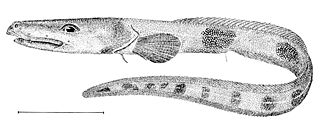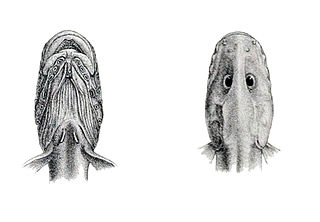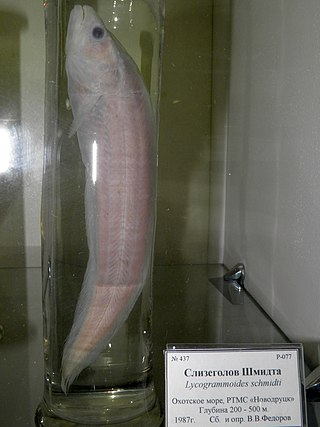The eelpouts are the ray-finned fish family Zoarcidae. As the common name suggests, they are somewhat eel-like in appearance. All of the roughly 300 species are marine and mostly bottom-dwelling, some at great depths. Eelpouts are predominantly found in the Northern Hemisphere. The arctic, north pacific and north Atlantic oceans have the highest concentration of species, however species are found around the globe.
Zoarces is a genus of marine ray-finned fishes belonging to the family Zoarcidae, the eelpouts. It is the only genus in the subfamily Zoarcinae. These eelpouts are found in the northern Atlantic and northern Pacific Oceans.
Aiakas is a genus of marine ray-finned fishes belonging to the family Zoarcidae the eelpouts. These fishes are found in the southwestern Atlantic Ocean.

Bothrocara is a genus of marine ray-finned fishes belonging to the family Zoarcidae, the eelpouts. They are found in the Pacific Ocean with one species reaching the southwestern Atlantic Ocean.

The popeye catalufa, also known as the bigeye soldierfish, is a species of marine ray-finned fish in the family Priacanthidae, the bigeyes. This fish has an overall dusky orange to red colour with white markings. The dorsal fin appears feathery while rest of fins have black margins. It occurs in the eastern Pacific, where it is found from Oregon to Chile. It occasionally makes its way into the aquarium trade. It grows to a size of 34 centimetres (13 in) in length. This species is nocturnal and shy, preferring deeper waters off islands. It has been recorded associating with squirrelfishes and cardinalfishes but the popeye catalufa goes as deep as 76 metres (249 ft), deeper than its associated species. This species has been recorded from rocky habitats at depths of less than 5 metres (16 ft) to over 100 metres (330 ft). It is a carnivorous species and, when kept in captivity, is known to feed on worms, crustaceans and brittle stars.
Lycodes is a genus of zoarcid fish in the subfamily Lycodinae. It is the most species-rich genus in its taxonomic family as well as in the Arctic Ocean and adjacent waters. They occupy both shallow waters and deeper waters down to 3000 meters. A few species can occur in brackish waters.

Lycenchelys is a genus of marine ray-finned fishes belonging to the family Zoarcidae, the eelpouts. The genus has almost cosmopolitan distribution.
The snubnose eelpout is a species of marine ray-finned fish belonging to the family Zoarcidae, the eelpouts. This species is found in the deep waters of the Atlantic and Pacific Oceans
Lycodes terraenovae, also called the Newfoundland eelpout, Atlantic eelpout or fish doctor, is a species of marine ray-finned fish belonging to the family Zoarcidae, the eelpouts. It is found in deep waters of the Atlantic Ocean.
Andriashevia is a monospecific genus of marine ray-finned fish belonging to the subfamiy Gymnelinae of the family Zoarcidae, the eelpouts, its only species is Andriasheevia aptera. It is found in the northwestern Pacific Ocean, where it occurs off the Pacific coast of Japan. It appears to be a demersal fish which is associated with large red gorgonian corals, e.g. Paragorgia. Examinations of the stomach contents of collected specimens has shown that its diet is mainly crustaceans but it likely also feeds on encrusting invertebrates which it searches for among coral branches and the hard substrates they live in. This species attains a maximum published standard length of 19.3 cm (7.6 in). Unlike other species in the subfamily Gymnelinae, this taxon has no pectoral fins. The genus name honours the Soviet ichthyologist Anatoly Petrovich Andriashev for his work on fishes of the Russian Far East and especially eelpouts. The specific name, aptera means "without wings" and refers to the absence of pectoral fins.
Bentartia is a genus of marine ray-finned fish belonging to the family Zoarcidae, the eelpouts. Some authorities treat this genus as monospecific, with the only species being Bentartia cinerea of the Southern Ocean, but other authorities include 4 species from the eastern Pacific Ocean.
The cuskpout is a species of marine ray-finned fish belonging to the family Zoarcidae, the eelpouts. It is the only species in the monospecific genus Derepodichthys and is found in the eastern North Pacific Ocean.
Dieidolycus is a genus of marine ray-finned fishes belonging to the family Zoarcidae, the eelpouts. The genus comprises three species which are found in the western central Pacific, southeastern Pacific and Southern Oceans.

Lycenchelys muraena, the moray wolf eel, is a species of marine ray-finned fish belonging to the family Zoarcidae, the eelpouts. It is found in the Arctic and North Atlantic Oceans.
Lycodapus is a genus of marine ray-finned fishes belonging to the family Zoarcidae, the eelpouts. The species in this genus are found in the Pacific and Southern Oceans.
Lycodes gracilis, Vahl's eelpout or the gracile eelpout, is a species of marine ray-finned fish belonging to the family Zoarcidae, the eelpouts. It is found in the eastern North Atlantic Ocean and adjacent areas of the Arctic Ocean.
Lycodonus is a genus of marine ray-finned fish belonging to the family Zoarcidae, the eelpouts. The species in this genus are found in the North and Southern Atlantic Ocean. These fishes are sometimes called scutepouts.

Lycogrammoides is a monospecific genus of marine ray-finned fish belonging to the family Zoarcidae, the eelpouts. Its only species is Lycogrammoides schmidti, a rare species of the Sea of Okhotsk in the northwestern Pacific Ocean.
The bearded eelpout is a species of marine ray-finned fish belonging to the family Zoarcidae, the eelpouts. This species is the only species in the monospecific genus Lyconema. It is found in the eastern Pacific Ocean.

Pyrolycus jaco is a species of eelpout. These organisms are typically distinguished by their eel-like morphology and, in certain species, facial features that evoke an appearance of "pouting". This species was discovered at Jacó Scar, hydrothermal seep site in the Pacific Ocean.






